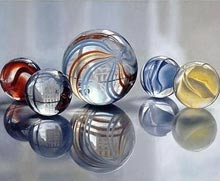 Marbles are a wonderful invention. They are a cheap but beautiful item with many uses. Early marbles were made of stone or clay but eventually of glass. Glass marbles are tiny works of art. Collector and glass dealer Cheryl Burnett certainly thinks so. She began collecting marbles when she bought a collection at auction. The marbles were not on her shopping list that day, but as soon as she saw them she knew they were something special. “I bought them before I knew anything about marbles. I just liked them,” she says.
Marbles are a wonderful invention. They are a cheap but beautiful item with many uses. Early marbles were made of stone or clay but eventually of glass. Glass marbles are tiny works of art. Collector and glass dealer Cheryl Burnett certainly thinks so. She began collecting marbles when she bought a collection at auction. The marbles were not on her shopping list that day, but as soon as she saw them she knew they were something special. “I bought them before I knew anything about marbles. I just liked them,” she says.
Cheryl found that her new collection was quite nice as she began researching. She told me that as she studied each one, she discovered the collection was a carefully put together overview of the history and technology of marbles. The most valuable was a tri-color sulphide, which is a clear marble with a rare painted figure placed in the glass. She later sold that marble to finance the purchase of more of the fascinating toys. She says that, along with the way they’re made, the names given to them caught her. Who wouldn’t love to own something called a “flaming dragon”?
 Glass marbles really began in Germany in 1846 when a glassblower invented scissors that could cut hot glass into small segments. These segments could then be rolled into balls. An early form of mass production allowed for speedy creation of the small glass orbs. By the early 1900’s a machine that could mass produce marbles was invented by Martin Frederick Christensen of Akron, Ohio. Akron became the home of toy marble making in the United States. Of course, marbles aren’t only made as toys. There are many industrial applications, such as the stirring device in spray paint cans, but none are as beautiful as the toys. The study of the history of marble making is rife with industrial spies, stolen recipes and court battles for patent rights. What a lot of drama for a little boy’s toy!
Glass marbles really began in Germany in 1846 when a glassblower invented scissors that could cut hot glass into small segments. These segments could then be rolled into balls. An early form of mass production allowed for speedy creation of the small glass orbs. By the early 1900’s a machine that could mass produce marbles was invented by Martin Frederick Christensen of Akron, Ohio. Akron became the home of toy marble making in the United States. Of course, marbles aren’t only made as toys. There are many industrial applications, such as the stirring device in spray paint cans, but none are as beautiful as the toys. The study of the history of marble making is rife with industrial spies, stolen recipes and court battles for patent rights. What a lot of drama for a little boy’s toy!
Anyone who collects glass is familiar with “end of day” glass, made from multiple strands of glass blended together mixing colors in stripes and swirls. Traditionally, this was the left over glass from the day’s production of wares. Some of the most beautiful objects, which are highly prized by collectors, are made of this “waste not, want not” product. (Who says recycling isn’t worthwhile?) Marbles were often produced by this method, as well as by blowing, casing and injection. In fact, studying toy marbles is a great way to learn about glass manufacturing processes. Manufactured glass marbles became Cheryl’s favorite group to collect since it appealed to her interest in glass production. She says that some of the most collectible machine-mades are the Akro-Agate corkscrews (they were the only company to make the twisted colored glass inserts). Most are two-color, but sometimes a third color left from another production run gets into the mix. These “mistakes” might have occurred in the first few marbles after a color change, but are rare and sought after. In fact, they are properly referred to as “hybrids” rather than “mistakes.”
There are many games created to play with marbles. One of my favorites as a child was to pop a marble into the frame at the end of a plastic tube to form a sort of kaleidoscope. I chose my favorite marbles based on how well they refracted light when I squinted through the tube. My dad’s favorite was the pock-marked shooter with which he had won many a playground tournament. By the way, when collector’s rate marbles, condition is very important. My dad’s well-worn example has little market value.
The most valuable marbles are usually hand-made examples or early manufactured ones, such as those produced by Christensen. There’s a great article available on the Collector’s Weekly website called “An Interview with Antique Marble Collector Alan Basinet” (June, 2009) that is full of information useful to new collectors. Cheryl told me that books and the Internet are a great way to start learning, but nothing teaches you like buying a jar full and sorting through them. Like any good dealer or collector, she believes you can’t understand an object fully until you’ve handled lots of examples. She likens marble collecting to panning for gold. “You sift through a lot of dirt before you find that bright, shining one of value.” What a great hobby, though, when the cast-offs are still fun to own. Cheryl will also remind you not to overlook the original boxes. Boxes in good condition with attractive art are collectible, even if there aren’t marbles in them.
Cheryl gave me so much information that I couldn’t possibly put it all in my small space. This is just an appetizer for those of you who love marbles or collect glass. If you have specific questions or would like a list of suggested references, she would be glad to provide that for you. Cheryl Burnett can be contacted at otay@islc.net or be phone at 843-252-3111. Tell her Libby sent you. I will caution you, don’t call unless you are prepared to fall in love with marbles.
Libby Holloway is a Certified Appraiser of antiques and residential contents. She is a member of the International Society of Appraisers where she is currently serving as Secretary of the Board of Directors. She is also a partner at Antiques and Such in Beaufort, SC. Libby can be contacted at www.LibbyHollowayAppraisals.com





